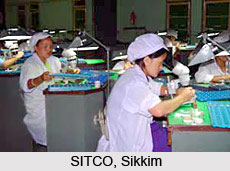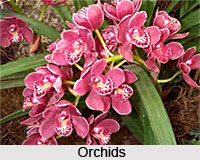 The economy of Sikkim is lrgely agrarian. The people in the rural ares grow cardamom, ginger, oranges, apples, tea and orchids. Rice is grown on the hillsides of the southern areas. Sikkim is the biggest producer of cardamom in India. The minerals mined in Sikkim are copper, dolomite, limestone, graphite, mica, iron and coal.
The economy of Sikkim is lrgely agrarian. The people in the rural ares grow cardamom, ginger, oranges, apples, tea and orchids. Rice is grown on the hillsides of the southern areas. Sikkim is the biggest producer of cardamom in India. The minerals mined in Sikkim are copper, dolomite, limestone, graphite, mica, iron and coal.
Breweries, distilleries, tanning and watch-making industries are located in the southern reaches of the state. The state has a growth rate of 8.3%, which is the second highest after Delhi . In regard to industrial development, a number of small and medium units have been promoted in the state. For example, the Sikkim Time Corporation (SITCO) and Government Institute of Handicraft and Handloom.
The innumerable streams and rivers flowing down the Himalayas have provided Sikkim with an immense potential for development of Hydro Electric Power. Pisiculture is an important economic activity. The states natural resources of freshwater rivers, lakes and streams offers conditions which are conducive for development of fisheries where a variety of carps and trout`s can thrive. In a rural country like Sikkim, animal husbandry activities form an extremely important element in the effort to bring about substantial improvements in living standards. Adequate number of livestock likes cattle, buffaloes, pigs, sheep`s, goats, yaks and few other are reared in Sikkim.
 Sikkim is a paradise of flowers like gladioli, anthuriums, lilliums, primulas, rhododendrons, and orchids. The government of Sikkim promotes tourism to a large extent. Tourism is the backbone of Sikkim`s economy which has bought economic prosperity to Sikkim. There are large numbers of places of tourist attraction particularly the snow-clad mountains, the lakes, the forest areas and valleys of flowers. The advantage of having very fine monasteries in Sikkim can also be taken to attract Buddhist tourists Fledgling industry of the state is the online gambling.
Sikkim is a paradise of flowers like gladioli, anthuriums, lilliums, primulas, rhododendrons, and orchids. The government of Sikkim promotes tourism to a large extent. Tourism is the backbone of Sikkim`s economy which has bought economic prosperity to Sikkim. There are large numbers of places of tourist attraction particularly the snow-clad mountains, the lakes, the forest areas and valleys of flowers. The advantage of having very fine monasteries in Sikkim can also be taken to attract Buddhist tourists Fledgling industry of the state is the online gambling.




















